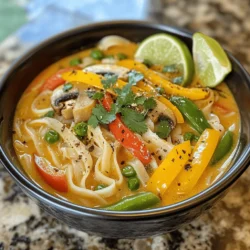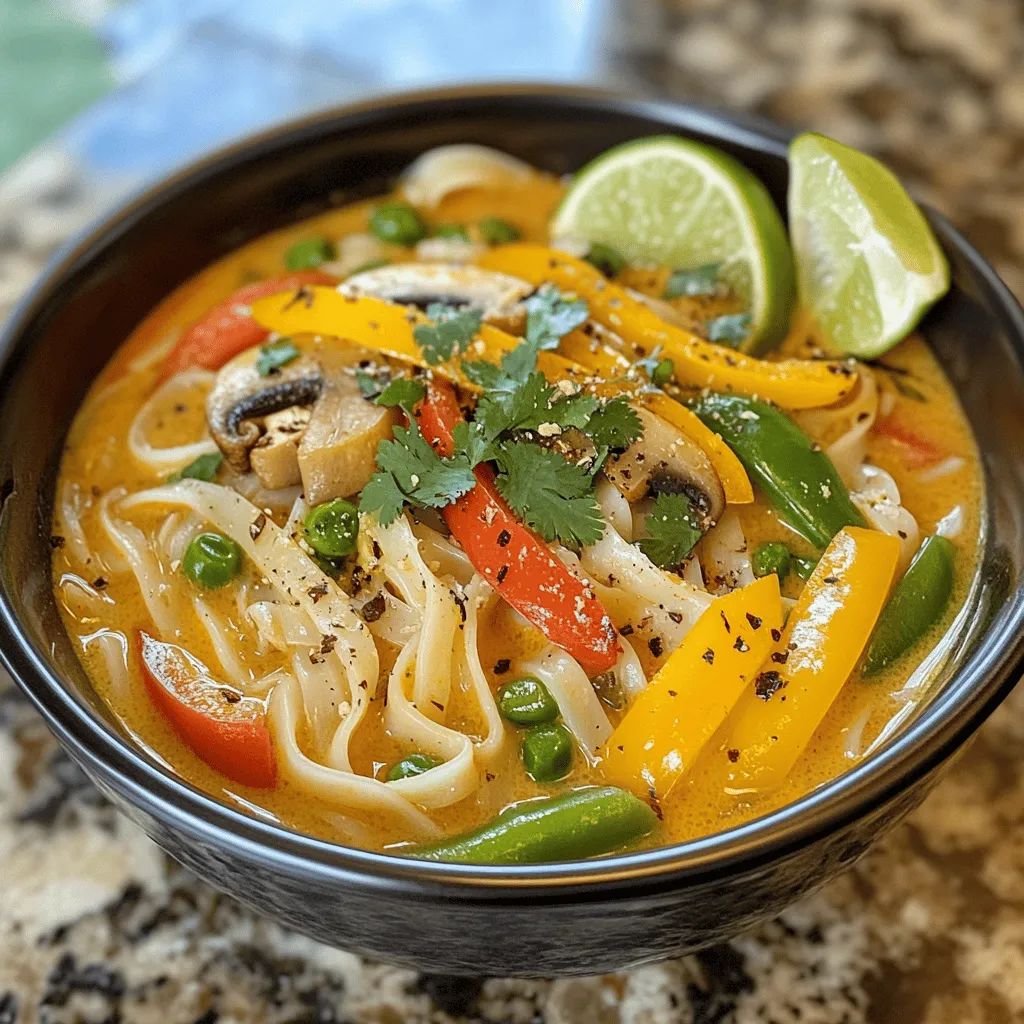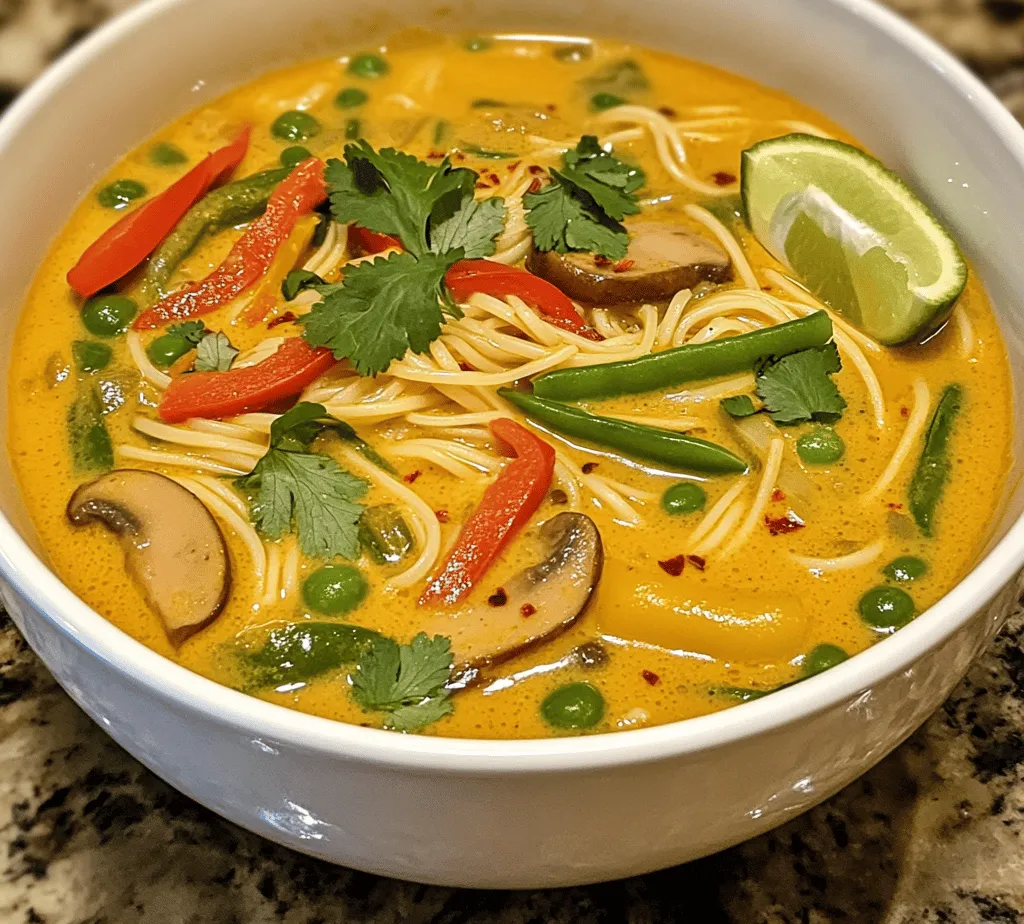Introduction
Thai cuisine is celebrated worldwide for its bold flavors, intricate balance of sweet, sour, salty, and spicy elements, and vibrant presentation. Each dish tells a story, often rooted in the rich cultural heritage of Thailand. Among the plethora of delightful offerings, Spicy & Comforting Thai Red Curry Noodle Soup stands out as a perfect embodiment of these characteristics, combining the warmth of a hearty soup with the invigorating punch of traditional Thai spices. This dish is not only a feast for the senses but also a soothing remedy for the soul, making it a go-to option for those seeking comfort in a bowl.
Homemade soups have long been associated with nurturing well-being and warmth, especially during cooler months or when one is feeling under the weather. The act of simmering ingredients together creates a fragrant, inviting atmosphere in the kitchen, reminiscent of family gatherings and cherished memories. With the right blend of spices and fresh ingredients, Thai Red Curry Noodle Soup promises to provide not just nourishment but also a delightful escape into the heart of Thai culinary tradition.
Understanding Thai Red Curry Noodle Soup
The origins of red curry in Thai cooking trace back to the central region of Thailand, where it has been a staple for centuries. Red curry, or “Gaeng Phed,” is characterized by its vibrant color and rich flavor profile, which is achieved through a meticulous blend of spices and herbs. The primary ingredient in red curry is the red curry paste, made from red chilies, garlic, lemongrass, and galangal, among other ingredients. This paste serves as the heart of the soup, infusing it with robust flavors and a distinctive heat that can be adjusted according to personal preference.
Noodle soups hold a special place in Thai cuisine, appreciated for their versatility and comforting qualities. They can be found in street stalls and fine dining establishments alike, offering a satisfying meal that warms the body and soul. The inclusion of noodles transforms a simple broth into a complete dish, making it both filling and nourishing. In the case of Thai Red Curry Noodle Soup, the combination of creamy coconut milk, aromatic spices, and fresh vegetables creates a symphony of flavors that is both spicy and comforting, perfect for any occasion.
Ingredients Breakdown
Creating the perfect bowl of Thai Red Curry Noodle Soup begins with selecting high-quality ingredients that contribute to its signature taste and texture. Below is a detailed description of each ingredient used in this recipe:
Rice Noodles
Rice noodles are the foundation of this dish, providing a light yet satisfying base. They come in various thicknesses, ranging from delicate vermicelli to broader flat noodles. For this recipe, medium-width rice noodles (often labeled as “pho” or “banh pho”) are ideal, as they absorb the rich flavors of the soup while maintaining a pleasing chewiness. When preparing rice noodles, it’s essential to cook them just until tender, as they will continue to soften when added to the hot soup.
Vegetable Oil
A neutral cooking oil is essential for sautéing the aromatics and developing the flavors in the soup. Vegetable oil, or other oils such as canola or coconut oil, is preferred for its high smoke point and mild flavor. This oil serves as the base for building the aromatic foundation of the soup, allowing the ingredients to meld beautifully.
Aromatics (Onion, Garlic, Ginger)
The trio of onion, garlic, and ginger is critical for creating a robust flavor base. Onions add sweetness and depth, while garlic infuses the dish with its pungent aroma. Ginger provides a fresh, zesty component that balances the richness of the coconut milk and the heat of the curry paste. Sautéing these aromatics until fragrant is a crucial step in layering flavors.
Red Curry Paste
Red curry paste is the star of the show in this dish, delivering the characteristic heat and complexity that Thai cuisine is known for. Made from a blend of red chilies, shallots, garlic, lemongrass, and spices, this paste can vary in spice level depending on the brand or homemade recipe. For a milder soup, you can start with a smaller amount of paste and adjust to taste, allowing for customization based on personal heat tolerance.
Coconut Milk
Coconut milk adds a luscious creaminess to the soup, balancing the heat from the red curry paste and enriching the overall flavor. The fat content in coconut milk not only contributes to the velvety texture but also enhances the absorption of flavors from the spices and other ingredients. For a lighter version, you can opt for light coconut milk, but the full-fat variety is recommended for the best taste and consistency.
Broth (Vegetable or Chicken)
Choosing the right broth is essential for achieving depth of flavor in your Thai Red Curry Noodle Soup. A high-quality vegetable broth offers a lighter alternative for a vegetarian soup, while chicken broth adds a savory richness. Homemade broth is always preferable, but store-bought options can also work well in a pinch. The broth serves as the base, bringing all the flavors together and providing nourishment.
Soy Sauce and Lime Juice
Soy sauce enhances the umami profile of the soup, adding a salty depth that complements the other ingredients. Lime juice is crucial for balancing flavors, providing a bright acidity that cuts through the richness of the coconut milk. Together, these components work harmoniously to elevate the overall taste of the dish.
Fresh Vegetables (Bell Peppers, Snap Peas, Mushrooms)
Fresh vegetables not only add color and texture to the soup but also offer a range of nutritional benefits. Bell peppers bring sweetness and crunch, snap peas offer a fresh bite, and mushrooms add an earthy depth. Feel free to customize the vegetable selection based on seasonal availability or personal preferences, as the versatility of this dish allows for various combinations.
Garnishes (Cilantro, Scallions, Lime Wedges)
Garnishes play a vital role in both the presentation and flavor enhancement of the soup. Fresh cilantro adds a burst of herbal freshness, while sliced scallions provide a subtle onion flavor and a pop of color. Lime wedges allow for an extra squeeze of acidity just before serving, giving the soup a refreshing finish.
Preparation Steps in Detail
Now that we have explored the essential ingredients, it’s time to dive into the preparation steps that will guide you through creating your Spicy & Comforting Thai Red Curry Noodle Soup:
Step 1: Preparing the Rice Noodles
Begin by preparing the rice noodles according to the package instructions. For most brands, this involves soaking them in hot water until they are al dente, rather than boiling them, which can lead to overcooking. Once they are ready, drain the noodles and rinse them under cold water to stop the cooking process and prevent them from sticking together. Set them aside while you prepare the soup base.
Step 2: Sautéing the Aromatics
In a large pot or Dutch oven, heat a tablespoon of vegetable oil over medium heat. Once the oil is shimmering, add the diced onion and sauté until translucent, about 4-5 minutes. Then, add minced garlic and grated ginger, cooking for an additional minute until fragrant. This step is crucial, as it builds the foundational flavors of your soup.
Step 3: Incorporating the Red Curry Paste
Next, add the red curry paste to the pot, stirring it into the sautéed aromatics. Cook the paste for about 2-3 minutes, allowing it to toast slightly and release its essential oils. This step intensifies the flavors of the curry and enhances the overall richness of the soup.
Step 4: Adding Coconut Milk and Broth
Once the curry paste is fragrant, pour in the coconut milk and broth of your choice. Stir well to combine all the ingredients, making sure to dissolve the curry paste completely. Bring the mixture to a gentle simmer, allowing the flavors to meld for about 5-10 minutes. This is the perfect time to taste the broth and adjust the seasoning with soy sauce, lime juice, or additional curry paste if desired.
Step 5: Adding Fresh Vegetables
After the broth has simmered and the flavors have developed, it’s time to add your fresh vegetables. Start with bell peppers and mushrooms, allowing them to cook for about 3-4 minutes until they start to soften. Then, add the snap peas, cooking for an additional minute to retain their crispness. Fresh vegetables not only enhance the nutritional profile of the soup but also contribute to its vibrant color and texture.
Step 6: Combining Noodles with the Soup
Finally, add the prepared rice noodles to the pot, gently stirring them into the soup to warm through. Allow the noodles to soak up the rich broth for a couple of minutes, ensuring they are well incorporated. This step transforms the soup into a satisfying meal, ready to be served.
With these initial steps, you’ve laid the groundwork for a delicious bowl of Spicy & Comforting Thai Red Curry Noodle Soup, combining the best of Thai flavors with the heartwarming essence of homemade cooking. As you continue with the remaining steps and garnishes, you’ll find that this dish not only delights your palate but also warms your spirit.



